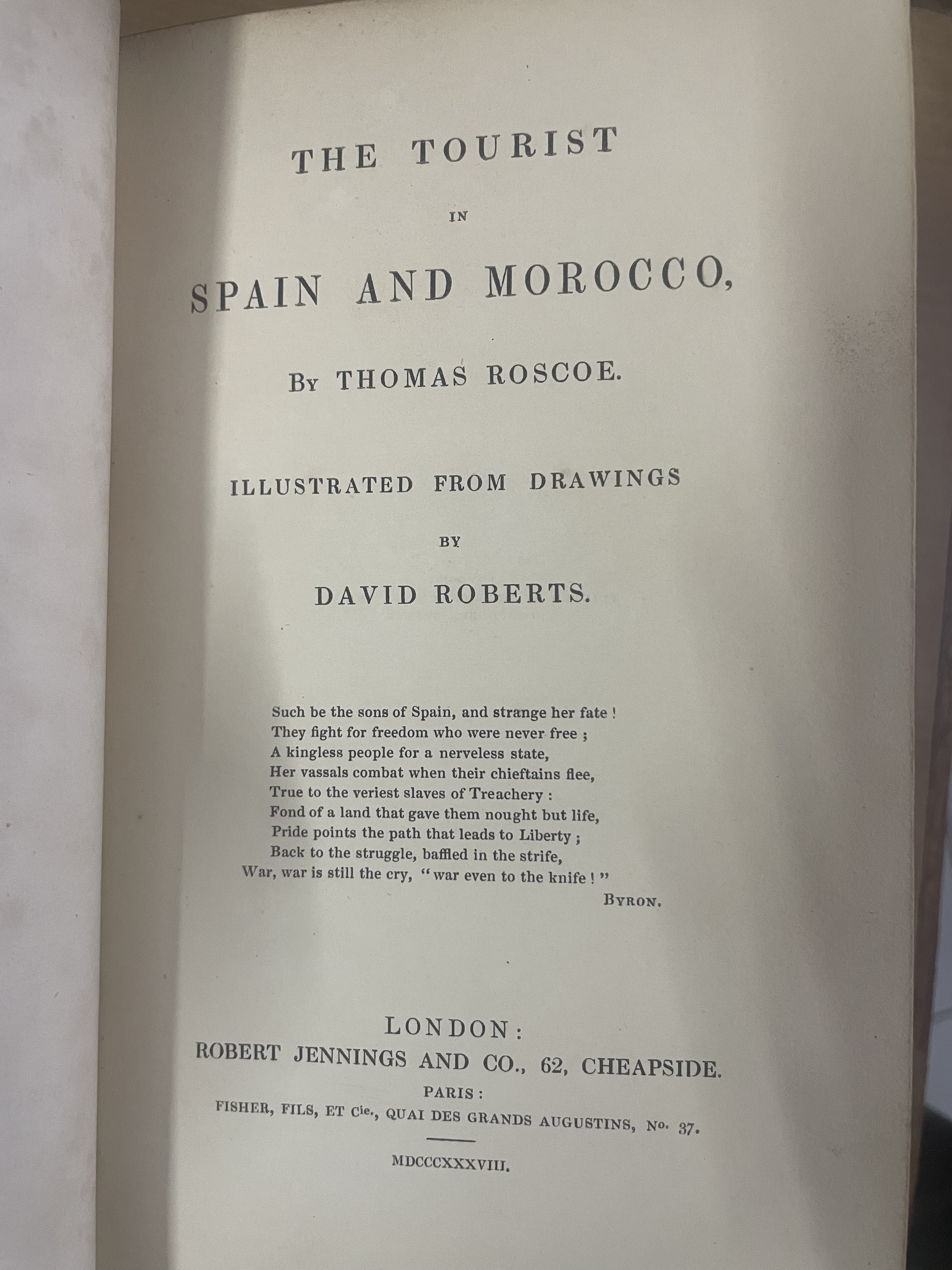The Tourist in Spain and Morocco

About
Summary
Exquisite
TOC
Details
Related
URL
Images
Overview
The Tourist in Spain and Morocco by Thomas Roscoe, published in 1838, is a travelogue that captures the author's experiences and observations during his journey through Spain and Morocco. Roscoe's work provides a glimpse into the cultural landscape, customs, and historical context of these regions during the Romantic era. It is illustrated with engravings after drawings.The Tourist in Spain and Morocco documents Roscoe's travels, providing descriptions of the landscapes, cities, architecture, and people he encountered. The book reflects the Romantic era's fascination with the exotic and picturesque. Roscoe's account also offers insights into the cultural and political dynamics of Spain and Morocco during the 1830s.
Key Themes
Romanticism and the Exotic: The book exemplifies the Romantic movement's interest in the exotic, picturesque, and culturally distinct regions of Spain and Morocco.
Cultural Encounters: Roscoe's narrative captures his encounters with the local populations, providing observations on their customs, traditions, and social structures.
Historical Reflection: The author reflects on the historical significance of the places he visits, particularly in Spain, where he explores the legacy of Al-Andalus and the Reconquista.
Orientalism: The book is influenced by Orientalist perspectives, which involve a Western gaze upon North Africa and the Middle East.
Travel and Exploration: It showcases the spirit of travel and exploration that characterized the 19th century, as writers ventured into less-familiar territories and documented their experiences.
Cultural Significance
Historical Documentation: Roscoe's work serves as a historical document, providing insights into the cultural and social landscapes of Spain and Morocco in the 1830s.
Representation of Spain and Morocco: The book contributed to shaping European perceptions of Spain and Morocco, influencing how these regions were imagined and understood.
Orientalist Discourse: It reflects the Orientalist discourse of the time, with its emphasis on the exotic, mysterious, and "otherness" of non-European cultures.
Artistic and Literary Inspiration: Roscoe's descriptions and observations may have inspired artists and writers who were drawn to the Romantic vision of Spain and Morocco.
Effects on Society
Shaping European Perceptions: The book played a role in shaping European perceptions of Spain and Morocco, contributing to both romanticized and stereotypical views.
Promoting Tourism: By portraying Spain and Morocco as attractive travel destinations, Roscoe's work may have contributed to the growth of tourism in these regions.
Reinforcing Cultural Binaries: The book may have reinforced cultural binaries between the West and the Orient, perpetuating asymmetrical power relations.
Contributing to Orientalist Stereotypes: By emphasizing the exotic and otherness of Moroccan culture, Roscoe's account may have contributed to Orientalist stereotypes
Conclusion
The Tourist in Spain and Morocco by Thomas Roscoe is a travelogue that offers a glimpse into Spain and Morocco in the 1830s through the eyes of a Romantic traveler. The book's cultural significance lies in its role as a historical document, its influence on European perceptions of these regions, and its reflection of Orientalist attitudes. By examining Roscoe's account, modern readers can gain insights into the complexities of cultural representation and the dynamics of travel writing during the 19th century.
Table of Content
The Tourist in Spain and Morocco (1838) is a travelogue by Richard Ford, a well-known British traveler and writer. This book offers a detailed account of Ford\'s experiences and observations during his travels in Spain and Morocco. While I don\'t have direct access to the specific table of contents of the 1838 edition, I can provide a general idea of what such a travelogue would likely include based on the content and structure typical of travel writing from that period.Table of Contents for The Tourist in Spain and Morocco (1838 Edition):
IntroductionOverview of the Journey
Purpose and Scope of the Travelogue
Part I: SpainChapter 1: Arrival in Spain
Initial Impressions
Overview of Spanish Culture and Customs
Chapter 2: Madrid
Key Landmarks and Attractions
Social and Cultural Observations
Chapter 3: Seville
Architectural and Historical Insights
Description of Local Life
Chapter 4: Granada
Alhambra and Other Notable Sites
Cultural Reflections
Chapter 5: Valencia and Alicante
Description of the Cities
Regional Characteristics
Chapter 6: Barcelona
Major Attractions and Architecture
Social Observations
Part II: MoroccoChapter 7: Arrival in Morocco
First Impressions and Initial Observations
Chapter 8: Tangier
Description of the City
Local Customs and Practices
Chapter 9: Fez
Cultural and Historical Insights
Notable Landmarks
Chapter 10: Marrakesh
Exploration of the City
Marketplaces and Local Life
Chapter 11: The Atlas Mountains and Other Regions
Observations on Geography and People
Travel Experiences in Rural Areas
ConclusionReflections on the Journey
Summary of Key Insights and Experiences
AppendicesMaps and Illustrations
Additional Notes and Observations
Title
The Tourist in Spain and Morocco
Author
Thomas Roscoe
Name of Publisher
Robert Jenings and Company London
Publish Date
1838
Subject
This structure aims to provide a comprehensive view of Ford\\\'s travels, offering readers insights into the regions he visited, the people he encountered, and the cultural and historical contexts of
Vintage
1801-1900
Number of Pages
292
Category
Travel
Sub Category
History
Rarity
RARE
